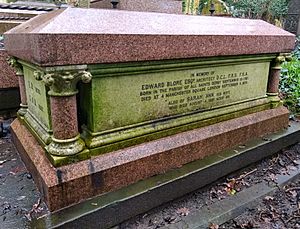Edward Blore facts for kids
Quick facts for kids
Edward Blore
|
|
|---|---|
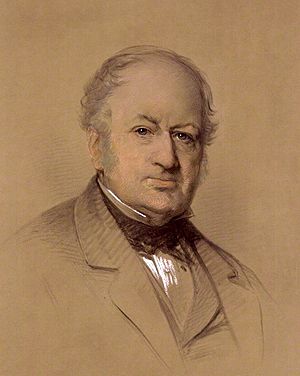
Blore, by Georg Koberwein (1820–1876)
|
|
| Born | 13 September 1787 Derby, England
|
| Died | 4 September 1879 (aged 91) Manchester Square, London
|
| Resting place | Highgate Cemetery West, London, England |
| Nationality | British |
| Occupation | Architect |
| Known for | Buckingham Palace; Lambeth Palace restoration |
Edward Blore (born September 13, 1787 – died September 4, 1879) was a famous English architect, artist, and historian from the 1800s. He is best known for his work on important buildings like Buckingham Palace and Westminster Abbey. Blore helped shape many well-known structures across England and even in other parts of the world.
Contents
Edward Blore's Early Life and Work
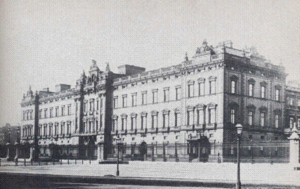
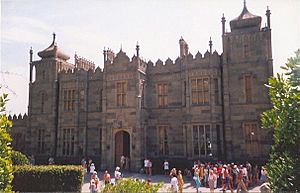
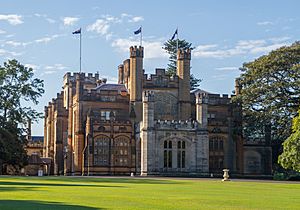
Edward Blore was born in Derby, England. His father, Thomas Blore, was a writer who studied old things and history. Edward didn't have formal training as an architect. Instead, he learned by drawing old buildings and historical items.
Even without formal training, Blore designed a huge palace for Prince Mikhail Semyonovich Vorontsov. This palace is called Vorontsov Palace and is located in Alupka, Crimea. He also designed parts of famous churches. These included organ cases for Winchester Cathedral and Peterborough Cathedral. He also designed the choir stalls in Westminster Abbey.
Blore was very good at drawing. He made illustrations for his father's book, History of Rutland, in 1811. He also drew detailed pictures of York Minster and Peterborough Cathedral. These drawings were for a book about English cathedrals. In 1816, he met the famous writer Walter Scott. Blore helped design Abbotsford House, Scott's home.
Working on Westminster Abbey and Lambeth Palace
In 1826, Edward Blore became the official architect for Westminster Abbey. This meant he was in charge of keeping the historic building in good shape. The next year, he planned changes for Peterborough Cathedral.
Soon after, he began restoring Lambeth Palace. This palace was very old and needed a lot of repair. Blore's work included building a special fire-proof room. This room was made to keep important old papers and records safe.
People admired Blore's careful attention to detail in his work. He had studied and drawn old buildings for so long. Because of this, he was very good at designing new parts that matched the old ones.
Edward Blore's Later Career
Blore is most famous for finishing Buckingham Palace. Another architect, John Nash, started the palace. But Nash was dismissed, and Blore took over. He completed the palace in a style that was similar to Nash's but simpler.
In 1847, Blore returned to Buckingham Palace. He designed the large front of the palace that faces The Mall. This design created the central courtyard we see today. He also worked on St James's Palace in London. He restored the Salisbury Tower at Windsor Castle.
Blore was a friend of Sir Walter Scott. Like Scott, he was interested in the old castle style of Scotland. This style is called the Scottish baronial style. This interest led Prince Vorontsov to ask Blore to design his large Vorontsov Palace in Alupka, Crimea.
The Alupka palace was built between 1828 and 1846. It mixes different styles, like Gothic Revival (looking like old European castles) and Moorish Revival (looking like buildings from North Africa and the Middle East). The palace has two main sides. One side looks like a Scottish castle, and the other side facing the sea looks like an Arabian fantasy.
As a well-known architect, Blore worked on many projects for the British Empire. This included Government House in Sydney, Australia. He designed it in 1834 to look like a Gothic castle. These designs showed a more adventurous side of Blore's work.
However, the front of Buckingham Palace that Blore designed was criticized. People thought it looked too plain. King George V later had this part of the palace redesigned in 1913. In 1841, Blore was chosen to be a Fellow of the Royal Society. This is a special honor for scientists and important thinkers.
Death and Legacy
Edward Blore died at his home in London on September 4, 1879. He was buried in Highgate Cemetery (West) in London.
Several architects learned from Edward Blore. These included Philip Charles Hardwick, Frederick Marrable, and Henry Clutton. William Mason also worked for him before moving to Australia and New Zealand.
Notable Buildings Designed or Worked on by Edward Blore
- Abbotsford House
- Bedford Modern School, now the Harpur Centre facade
- Buckingham Palace
- Cambridge University Press: Pitt Building
- Chapel at College of St Mark and St John, London (1841)
- Christ Church (formerly Holy Trinity) Waltham Cross (1831-2)
- Crewe Hall, Cheshire: alterations and estate buildings
- Crom Castle, County Fermanagh, Ulster
- Goodrich Court, Herefordshire (1828)
- Government House, Sydney (1835)
- Great Moreton Hall, Congleton, Cheshire (1841–1843)
- Kingston Hall, Nottinghamshire (1842–1846)
- Lambeth Palace: restoration
- St James's Palace: alterations
- St John's Church, Stratford, London (1833–1834)
- St John the Baptist, Leytonstone, London (1832-1833)
- St Peter's Church, Stepney, London (1837–1838)
- St Thomas, Charterhouse. London, 1842
- Trinity Hospital, Retford, 1833 (Grade II listed)
- Vorontsov Palace, Alupka
- Warminster Town Hall, Wiltshire (c.1837); imitates Longleat
- Watt Library, Greenock
- Westminster Abbey: choir and screen
See also
- List of ecclesiastical works by Edward Blore
- List of miscellaneous works by Edward Blore
- List of works by Edward Blore on palaces and large houses


